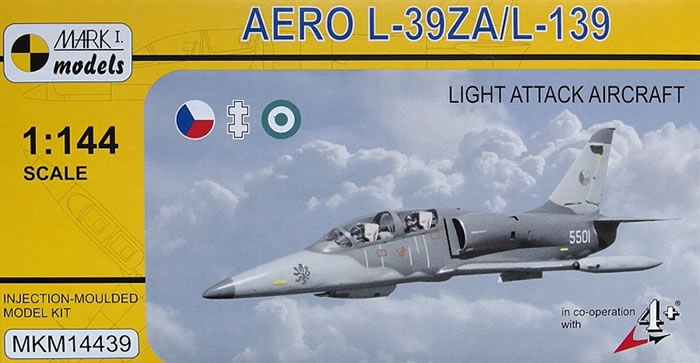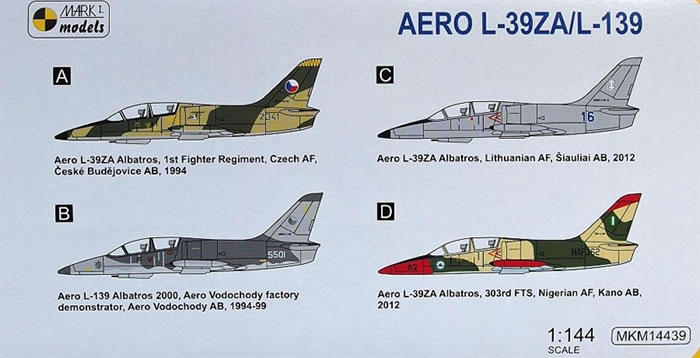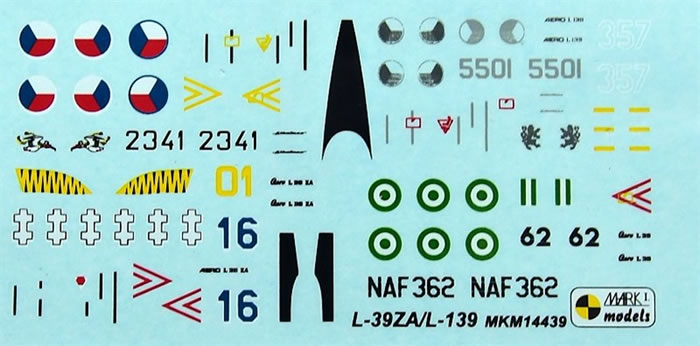|
Aero L-39ZA / L-139

Mark I Models, 1/144 scale
S u m m a r y : |
Catalogue Number: |
Mark I Models Kit No. MKM14439 - Aero L-39ZA / L-139 |
Scale: |
1/144 |
Contents & Media |
52 tan coloured plastic parts; two clear styrene parts; one PE fret; decals for four subjects. |
Price: |
Available online from Hannants for £8.75 and Modelimex for €11.57. |
Review Type: |
First Look |
Advantages: |
Simple to build kit. |
Disadvantages: |
Imprecise colour guidance (but easily remedied). |
Conclusions: |
This is a very simple good quality kit of an attractive aircraft. The moulding has sufficient finesse that I think the eye will be drawn away from any unavoidable slightly over-scale elements.
Colour cross-referencing would have been helpful, as I do not like to rely on the printed shades provided on boxes or in instructions. But this can be overcome by a resourceful modeller who cares about such things.
The kit should be very easy to build. Neatly finished; it has the potential to produce a little gem of a model that will be very undemanding on display space - Recommended. |
Reviewed by Mark Davies

RS Models 1/72 scale Miles Magister is available online from Squadron.com
Background
The Aero L-39 Albatros is a high-performance jet trainer aircraft developed in Czechoslovakia to meet requirements for a "C-39" (C for cvicny – trainer) during the 1960s to replace the L-29 Delfín. It was the first of the second-generation jet trainers, and the first turbofan-powered trainer produced, and was later updated as the L-59 Super Albatros and as the L-139 (prototype L-39 with Garrett TFE731 engine).

A further development of the design, the L-159 ALCA, began production in 1997. To date, more than 2,800 L-39s have served with over 30 air forces around the world. The Albatros is the most widely used jet trainer in the world; in addition to performing basic and advanced pilot training, it has also flown combat missions in a light-attack role. Atypically, it has never received a NATO reporting name.
Source: Wikipedia
Mark I Ltd is well known for their 4+ range of aviation booklets, Mark I Guides and decal sets, the CMR range of resin kits, and the Attack Hobbies 1/144-scale range of jet aircraft. This last range was re-boxed and released with new decals, along with two ex-Eduard 1/144 kits of the Bf 109G & Fw 190A. Mark I has also released its own new tool 1/144-scale kits covering different versions of the Westland Wessex, Heinkel He 219, and Focke-Wulf Ta 152H.
Contents
The kits comes packed in a good quality end-opening box with nice artwork on the front, and a painting and decaling guides for the four decal options on its rear. All parts are sealed in a plastic bag, along with the decals and instructions.
The instructions are formed by a fold-out sheet with colour printing. They include a parts map and clear assembly diagrams that are easy to follow. All text is in English, with detail colour call-outs included.
The instructions include a four-view coloured painting and markings guide for each option, with generic colour names used for the main colours in three of four cases. The exception is a Czech AF scheme, which includes what I assume are the last four digits of the applicable FS-595 code numbers. I feel a more precise colour reference would have been helpful here, such as FS-595 equivalents or cross-reference to a readily available model paint range. However, a bit of Googling or asking questions on modelling forums should clarify the exact shades to use.
The instructions allow for a variety of external stores that are included in the kit, and include diagrams showing which version should carry what.
The base kit is originally by Attack Hobbies, and is available in three other boxings from Mark I Models; these being: MKM14406 Aero L-39ZO/ZA/ART Albatros, MKM14412 Aero L-39C/ZO Albatros “in US Colours", and MKM144114 Aero L-39V with Letov KT-04.
The Kit
The kit follows a conventional breakdown for this type of aircraft and all parts are crisply moulded with delicate recessed panel line detail.
The cockpit is formed from a styrene tub, basic ejection seat and what I guess is the winch cable-reel where the rear seat would otherwise be. The instrument panel is a solid blank face and there is no control column (although one can easily be made from scratch). The basic detail does not seem to matter too much in this small scale. The canopy is clear and reasonably thin, but its curvature will lead to some distortion when viewing the interior.
This kit’s airframe should be very quick to build as the wings and horizontal stabilisers are one-piece mouldings; with only the air-intakes, exhaust nozzle, and undercarriage needed to complete the main structure. The undercarriage is very simple but quite finely moulded. It can be seen from the parts photos that there are no wheel wells; just holes for the undercarriage legs to insert into. This is quite correct, as the L-39 has fully closed wheels when the undercarriage is down, as can be seen here and here. With solid one-piece wing there are no blind locating holes to punch out for the weapon pylons, but their locations and distance in millimetres across the wing’s span are given in a diagram.

The kit captures the lines of the real aircraft and high degree of moulding finesse. Yes, in theory panel lines in 1/144-scale are going to be overdone no matter how fine the moulding, but most would want something represented to add interest to the model. The overall quality is good.
Colours & Markings
The four colour schemes offered with this the kit; these are:
-
L-39ZA Albatros, Black 2341, 1st Fighter Regiment, Czech Air Force (letectvo Armady Ceske Republiky), Ceske Budejovice Air Base, 1994
-
L-139 Albatros 2000, Grey 5501, Aero Vodochody factory demonstrator, Aero Vodochody Air Base, 1994-99
-
L-39ZA Albatros, Blue 16, Lithuanian Air Force, Siauliai Air Base, 2012
-
L-39ZA Albatros, Black NAF362/62, 303rd Flying Training School, Nigerian Air Force, Kano Air Base, 2012.

The decals appear to be excellent, as we would expect given the company's background in decal production.
This is a very simple good quality kit of an attractive aircraft. The moulding has sufficient finesse that I think the eye will be drawn away from any unavoidable slightly over-scale elements.
Colour cross-referencing would have been helpful, as I do not like to rely on the printed shades provided on boxes or in instructions. But this can be overcome by a resourceful modeller who cares about such things.
The kit should be very easy to build. Neatly finished; it has the potential to produce a little gem of a model that will be very undemanding on display space.
Recommended.
Thanks to Mark I Ltd for the review sample
Review Text & Images Copyright © 2015 by Mark Davies
Page Created 12 May, 2015
Last updated
12 May, 2015
Back to HyperScale Main Page
Back to Reviews Page

|
